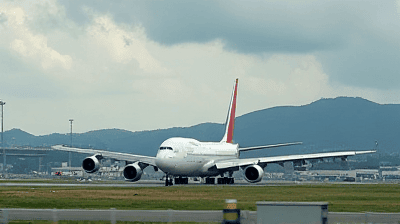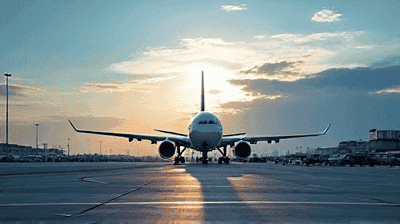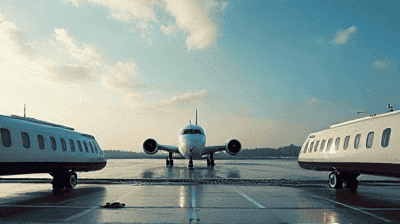
As air travel becomes an increasingly vital aspect of modern life, the environmental impact of airports, particularly noise pollution, cannot be overlooked. Noise generated by aircraft during takeoff, landing, and taxiing poses significant challenges for nearby communities. The ramifications of airport noise extend beyond mere inconvenience; they can affect public health, quality of life, and property values. In response to these concerns, governments and aviation authorities around the world have established noise regulations that aim to mitigate these effects and protect the well-being of local residents.
Airport noise pollution refers to the disruptive sounds produced by aircraft operations at airports, primarily during takeoff, landing, and ground movements. This noise is usually measured in decibels (dB) and can reach high levels, particularly in the vicinity of busy airports. Key sources of airport noise include:
Takeoff and Landing: The engines of aircraft produce significant noise during these phases of flight. Depending on the type of aircraft and its weight, noise levels can vary widely.
Taxiing Operations: Aircraft also generate noise while taxiing on the runway and taxiways, contributing to overall airport noise pollution.
Ground Support Equipment: Equipment used for loading cargo, refueling, and maintenance can add to the noise levels experienced by nearby communities.
The effects of airport noise pollution on communities can be profound and multifaceted, impacting both physical and mental well-being. Key impacts include:
Health Issues: Exposure to elevated noise levels has been linked to various health issues, including stress, sleep disturbances, cardiovascular problems, and impaired cognitive function.
Annoyance and Disturbance: Chronic exposure to noise pollution can lead to significant annoyance among residents, affecting their overall quality of life. This annoyance can manifest as increased irritability, reduced productivity, and social discord.
Property Values: Homes located in proximity to airports often experience reduced property values due to the negative perception of living near a noisy environment. This can have substantial financial implications for homeowners.
Impact on Wildlife: Increased noise levels can disrupt local wildlife, interfering with mating calls, foraging behaviors, and overall habitat use. This ecological disruption can jeopardize biodiversity in affected areas.
Given the significant impacts of airport noise pollution, there is a pressing need for effective noise regulations. Governments and aviation authorities implement these regulations to address community concerns and promote sustainable development while balancing the needs of aviation.

Airport noise regulations vary by country and region, but they generally incorporate several key principles:
Noise Abatement Procedures: These refer to operational practices that airlines and pilots can adopt to minimize noise during critical phases of flight. This may include specific takeoff and landing procedures designed to limit noise exposure to communities.
Flight Path Management: Authorities may designate specific flight paths that minimize noise over densely populated areas. By directing air traffic away from residential neighborhoods, they can reduce the environmental impact of airport operations.
Noise Limits: Many airports establish noise limits based on the average decibel levels experienced by communities. Violations of these limits can result in penalties for airlines and may lead to corrective actions.
Land Use Planning: Comprehensive land use planning around airports helps mitigate the impact of noise pollution. This may involve zoning regulations that restrict certain types of developments, such as schools and residential areas, within defined noise zones.
Successful implementation of noise regulations typically involves collaboration among various stakeholders, including:
Government Authorities: Local, regional, and national governmental bodies are often responsible for establishing and enforcing noise regulations.
Airport Operators: These authorities are responsible for implementing noise reduction measures, assessing community impacts, and maintaining compliance with regulations.
Airlines: Airlines play a critical role in adhering to noise abatement procedures and ensuring that their operations align with noise regulations.
Community Groups: Local residents and community organizations often advocate for noise reduction measures and can provide valuable input into the decision-making process.
Modern airports often employ advanced noise monitoring systems to measure noise levels in real-time. Key features of these systems include:
Fixed Noise Monitoring Stations: These strategically placed stations collect data on noise levels and patterns throughout the day and night. This information is crucial for assessing the effectiveness of noise regulations.
Real-Time Data Analysis: Advanced software analyzes noise data, providing authorities with insights into trends and hotspots of noise pollution.
Community Accessibility: Many airports offer online platforms where residents can access noise data, increasing transparency and trust between the airport and the surrounding communities.
Many airports establish designated quiet zones to protect sensitive areas from excessive noise. These zones typically cover:
Residential Areas: Designating specific neighborhoods as quiet zones helps protect them from significant noise exposure.
Schools and Hospitals: Establishing quiet zones around educational institutions and healthcare facilities is particularly important, given their sensitivity to noise.
Public Parks and Recreation Areas: Protecting parks and green spaces contributes to quality of life while allowing residents to enjoy outdoor activities without intrusion from airport noise.
To minimize noise impacts, many airports implement operational restrictions for certain hours of the day:
Curfews: Some airports impose nighttime curfews, preventing takeoffs and landings during specified hours to reduce noise disturbances while residents are sleeping.
Noise Preferential Runway Use: Airports may designate specific runways for use during certain periods, directing traffic away from densely populated areas whenever possible.
Aircraft Type Restrictions: Regulations may restrict the types of aircraft permitted to operate at certain times or altogether, focusing on those that meet stricter noise performance standards.
Many airports engage in community outreach efforts to educate residents about noise regulations and the steps being taken to mitigate impacts. Effective initiatives include:
Public Meetings: Hosting regular community meetings allows residents to voice their concerns, ask questions, and receive updates on ongoing efforts to address noise pollution.
Educational Programs: Informational campaigns can educate residents about the technology behind modern aircraft, the operational changes in use, and the various regulations in place.
Community Partnerships: Collaborating with local organizations and schools provides platforms for joint efforts in noise reduction and enhances community engagement.

Noise regulations have demonstrable benefits for public health, particularly in areas near airports. Key health implications include:
Reduced Stress Levels: By minimizing exposure to elevated noise levels, communities experience lower stress levels, leading to improved overall health outcomes.
Better Sleep Quality: Nighttime curfews and reduced aircraft operations during late hours contribute to enhanced sleep quality among residents living near airports.
Decreased Cardiovascular Risks: Studies have linked chronic noise exposure to increased cardiovascular risks; therefore, effective noise regulations can help mitigate these health threats.
Certain populations, such as children, the elderly, and individuals with pre-existing health conditions, are particularly vulnerable to the effects of noise pollution. Noise regulations help protect these groups by ensuring:
Silent Spaces for Children: Limited noise exposure is critical for healthy childhood development, as it supports cognitive functions and reduces behavioral issues related to stress.
Safe Environments for the Elderly: Reducing noise pollution benefits senior citizens, who may be more sensitive to auditory disturbances, thereby enhancing their quality of life.
Healthcare Facilities: Regulations that shield hospitals and clinics from excessive noise foster healing environments, promoting better health outcomes for patients.
Effective noise regulations play a vital role in safeguarding property values for homes located near airports. Key points include:
Retention of Home Values: Properties located within defined noise zones often see depreciation in market value due to noise-related concerns. Effective noise regulations help stabilize property values.
Attractiveness of Neighborhoods: Quieter neighborhoods with effective noise restrictions tend to be more appealing to potential homebuyers, thereby enhancing community desirability.
While noise regulations may impose constraints on airport operations, they can also yield positive economic benefits:
Sustainable Growth of Airports: By mitigating noise concerns, airports can secure community support and ensure the sustainable growth of aviation infrastructure.
Incentivizing Noise-Reducing Technologies: Regulations can drive innovation among manufacturers, as companies invest in quieter aircraft designs that meet regulatory standards, benefiting the entire industry.
Tourism and Business Attraction: Quieter airport operations foster a positive image, encouraging tourism and business investment in nearby areas, leading to economic development.
The costs associated with implementing noise regulations can vary and must be balanced against their benefits:
Infrastructure Investments: Airports may need to invest in soundproofing buildings and constructing noise barriers, which can require significant financial resources.
Operational Adjustments: Changes to flight patterns and schedules may have financial implications for both airlines and airports, necessitating careful planning and consideration.

Innovations in aircraft design have led to the development of quieter engines and improved aerodynamics, significantly reducing noise emissions:
Next-Generation Turbofan Engines: Modern turbofan engines are designed to operate more quietly, resulting in substantial reductions in noise levels.
Noise-Reducing Features: Enhanced features, such as chevrons on engine nacelles, minimize airflow turbulence, thereby reducing noise.
The implementation of noise abatement procedures can aid pilots and air traffic controllers in reducing noise emissions during takeoff and landing. Examples include:
Optimized Flight Paths: Developing and employing optimized flight paths helps to minimize noise exposure in noise-sensitive areas during critical phases of flight.
Continuous Descent Approaches: Instead of noise-intensive level flight, implementing continuous descent approaches allows aircraft to glide gradually to the runway, resulting in quieter landings.
Advanced noise modeling software allows airports to simulate noise impacts associated with various operational scenarios, aiding in effective planning and decision-making:
Predictive Analytics: Noise modeling enables officials to foresee potential noise impacts from proposed changes, facilitating proactive management of community concerns.
Dynamic Zone Management: Technology allows airports to dynamically adjust operations based on real-time noise data, responding swiftly to changes in environmental conditions and public sentiment.
Los Angeles International Airport has implemented comprehensive noise regulations to mitigate the impact of aircraft noise on surrounding communities:
Noise Monitoring System: LAX utilizes a sophisticated monitoring system to record noise levels in real-time. This data is analyzed to ensure compliance with noise limits.
Curfews and Flight Path Adjustments: The airport has instituted nighttime curfews and adjusted flight paths to minimize noise exposure over residential areas.
Heathrow Airport in London illustrates the importance of community engagement in addressing noise pollution:
Community Interaction: Heathrow has engaged in extensive consultations with local residents to understand their concerns, resulting in the establishment of the Heathrow Community Noise Forum.
Partnerships: The airport collaborates with local authorities to modify procedures and regulations to reduce noise impacts effectively.
Frankfurt Airport demonstrates how the integration of technology can enhance noise management efforts:
Predictive Noise Models: The airport employs sophisticated noise modeling software to analyze potential noise impacts and monitor compliance with regulations.
Investment in Quieter Aircraft: Frankfurt has encouraged airlines to upgrade to quieter aircraft as part of its noise reduction strategy, resulting in decreased noise levels over time.
As air travel continues to grow, it is important for noise regulations to adapt and evolve in response to changing circumstances, including technology advancements and community needs:
Regular Updates: Regulatory frameworks should be reviewed and updated regularly to incorporate best practices and recent advances in aircraft technology.
Greater Flexibility: Authorities may consider adopting more flexible noise standards that can adjust based on real-time data and community feedback.
Engaging communities in ongoing dialogue about noise regulations is essential for fostering positive relationships and strengthening trust:
Continuous Feedback Mechanisms: Establishing platforms for ongoing resident feedback allows authorities to remain informed about community concerns regarding noise pollution.
Participatory Decision-Making: Including community representatives in decision-making processes ensures that regulations reflect local priorities and interests.
Future noise regulations can benefit from an integrated approach that aligns noise mitigation with broader climate goals:
Sustainable Aircraft Technology: Encouraging the ongoing innovation of greener aircraft technologies can lead to simultaneous improvements in noise reduction and lower carbon emissions.
Supportive Policies: Integrated land use and transportation policies that prioritize sustainability, noise reduction, and environmental quality will enhance the overall effectiveness of noise regulation efforts.
Noise pollution from airports poses significant challenges for nearby communities, affecting public health, quality of life, and property values. Effective noise regulations are essential to mitigate these impacts and protect residents from the disruptive effects of aircraft noise. Through a collaborative approach involving community engagement, advanced monitoring systems, and innovative technologies, airports can enhance their operational practices while creating a more harmonious coexistence with the surrounding environment.
As air travel continues to grow in importance, prioritizing noise regulation will play a critical role in ensuring sustainable development and maintaining the well-being of communities adjacent to airports. By investing in effective noise management strategies, airports can contribute to healthier, quieter environments, fostering positive relationships with the communities they serve.